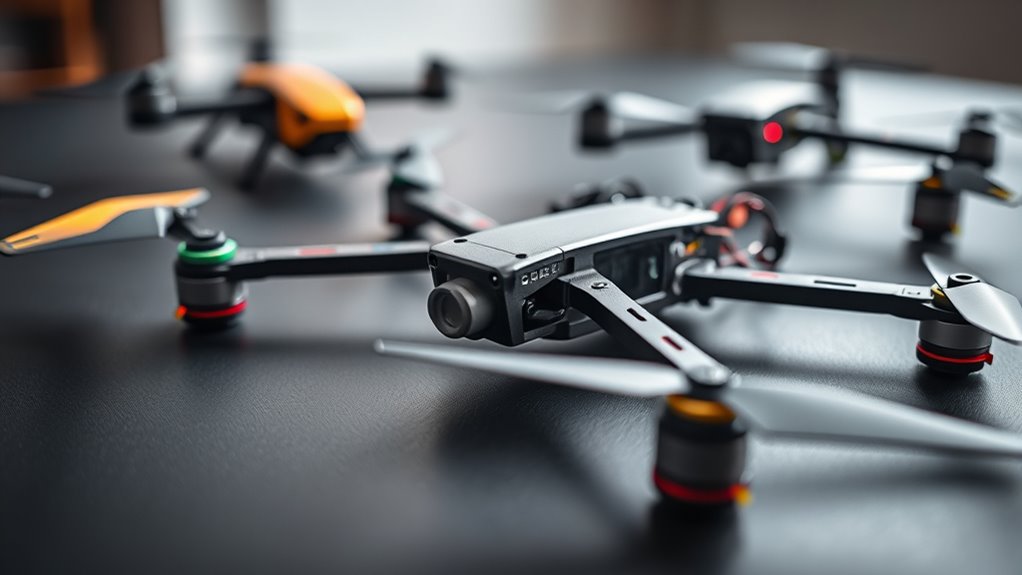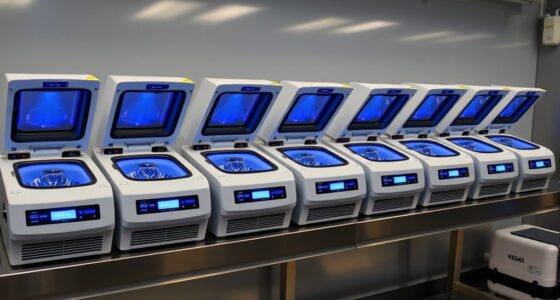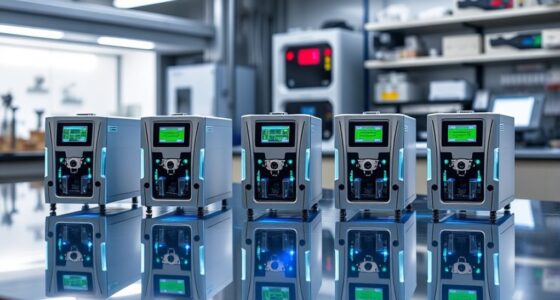If you’re looking to advance your research projects in 2025, I recommend exploring top modular drone kits like the N11 Pro GPS Drone, X1 PROMAX, and DJI Mini 3 Fly More Combo. These kits offer high customizability, strong performance, and advanced features like 4K cameras, long flight times, and obstacle avoidance. With options suitable for DIY builders and educators, you’ll find something that fits your needs. Keep going to discover more about the best choices for your experiments and innovations.
Key Takeaways
- Focus on kits with open-source controllers and customizable components suitable for research and experimental modifications.
- Prioritize modular designs that allow easy sensor integration like LiDAR, GPS, and obstacle avoidance modules.
- Select kits with detailed assembly instructions, firmware support, and compatibility with advanced software tools.
- Consider durable, lightweight frames that support indoor and outdoor research applications and payload attachments.
- Evaluate kits offering expandability, such as additional payload capacity, multi-sensor integration, and upgrade options for future projects.
N11 Pro GPS Drone with Camera (4K UHD, 90 Minutes Flight, Auto Return, Tracking, Brushless Propulsion, Long Range, 5G FPV)

If you’re looking for a reliable drone to support research projects, the N11 Pro GPS Drone with Camera stands out thanks to its 4K UHD camera and extended 90-minute flight time. Its lightweight, foldable design makes it easy to transport, weighing just 6.3 ounces and fitting into a compact carrying case. The drone offers a control range over 3,300 feet, GPS stabilization, auto-return, and precise tracking features. Equipped with brushless alloy motors, it ensures quiet, powerful flights suitable for capturing high-quality images and videos. The 5G FPV connection delivers real-time live video, making it an excellent tool for detailed aerial data collection and analysis.
Best For: hobbyists, semi-professional photographers, and researchers seeking high-quality aerial imagery with long flight times and advanced GPS features.
Pros:
- Extended 90-minute flight time with three batteries for prolonged aerial activities
- High-resolution 4K UHD camera with adjustable lens and 5G FPV for clear, real-time video streaming
- Robust GPS stabilization, auto-return, and tracking modes for stable, precise flights and easy operation
Cons:
- Relatively higher price point compared to basic drones, which may be a consideration for budget-conscious users
- Larger size compared to compact drones, potentially less convenient for quick transport or indoor use
- Requires some setup and calibration, which might be challenging for complete beginners
X1 PROMAX 8K Action Flying Camera Drone
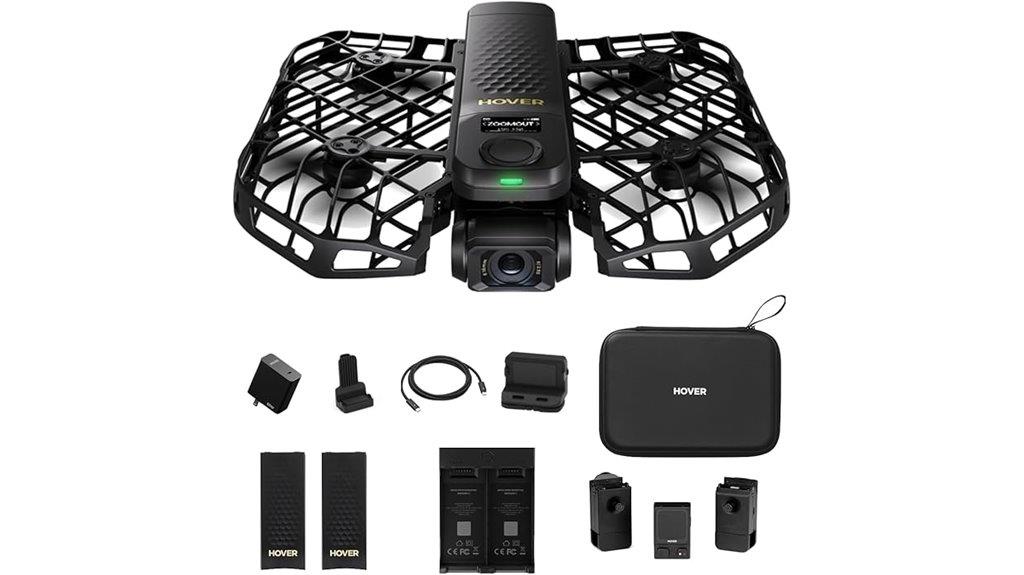
The X1 PROMAX 8K Action Flying Camera Drone stands out with its advanced stabilization system, making it an excellent choice for research teams needing high-quality, steady footage in dynamic environments. Its 8K@30fps resolution and 4K vertical videos deliver cinematic clarity, while features like a two-axis gimbal, EIS, and horizon leveling guarantee smooth, stable shots. Its foldable, lightweight design and propellor guards enhance portability and safety. With over 10 flight modes, obstacle detection, and automated controls like gesture commands, it offers versatile operation across terrains. This drone’s combination of high performance, durability, and user-friendly features make it a top pick for advanced research applications.
Best For: researchers, content creators, and outdoor enthusiasts seeking high-quality, stable footage in dynamic environments with advanced automation and portability.
Pros:
- Exceptional 8K@30fps video quality with cinematic clarity and stable footage via advanced stabilization systems
- Foldable, lightweight design with propellor guards for easy portability and safety in various terrains
- Multiple automated flight modes, obstacle detection, and gesture controls for versatile, hands-free operation
Cons:
- Lacks a dedicated remote control or FPV goggles for real-time first-person viewing
- Slightly limited color profile options, which may require post-processing for professional use
- Internal storage is 32GB, requiring SD card expansion for larger data needs
GPS Drone with 5.9 Inch Screen Controller, Landing Pad, 4k Dual Camera,Auto Return,Obstacle Avoidance, Optical Flow Mode,5G Drone,2 Battery 40 Mins Flight, Drones for Beginner (Black)
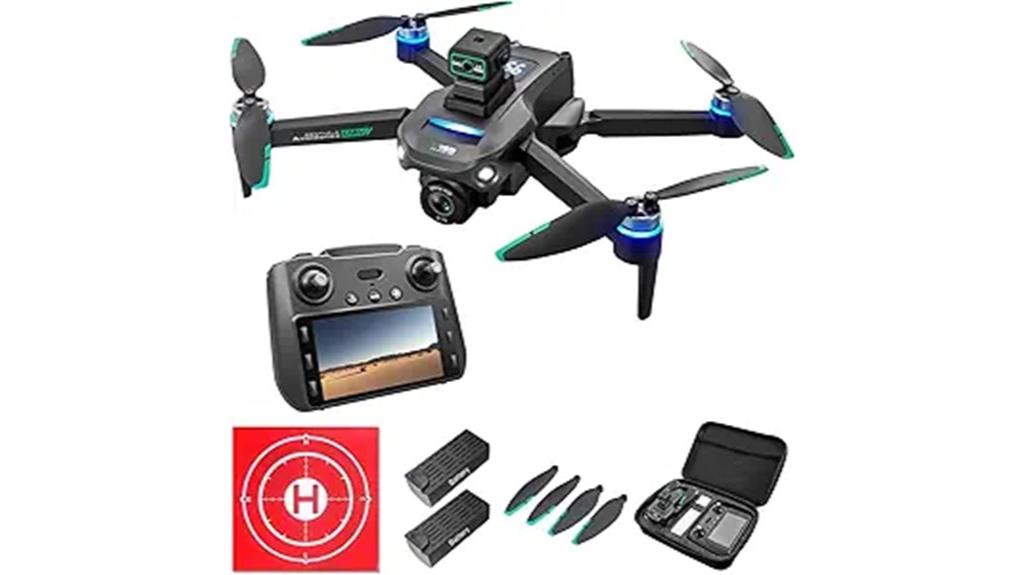
Designed with beginners in mind, this GPS drone offers a user-friendly experience thanks to its intuitive controls, stable flight features, and safety mechanisms like obstacle avoidance and auto return. The 5.9-inch controller screen provides real-time flight data, while the included landing pad makes takeoff and landing easier. Equipped with a 4K dual camera and optical flow technology, it delivers stable footage and precise hovering. With 5G connectivity, two batteries, and a total flight time of 40 minutes, it’s ideal for learning and casual use. Despite some control challenges and mixed reviews, it’s a solid choice for those starting drone exploration.
Best For: beginners and casual drone enthusiasts seeking an easy-to-use GPS drone with stable flight and basic imaging capabilities.
Pros:
- User-friendly controls with intuitive features suitable for beginners.
- Equipped with obstacle avoidance, auto return, and optical flow technology for safe and stable flights.
- Includes a landing pad and two batteries, offering up to 40 minutes of flight time.
Cons:
- Some users experience difficulty controlling the drone and inconsistent manual instructions.
- Video footage can be shaky, and the overall build quality may be subpar.
- Limited advanced features such as waypoint navigation and longer control range, with mixed reviews on performance.
DJI Mini 3 Fly More Combo Drone with Camera (DJI RC)

The DJI Mini 3 Fly More Combo Drone with Camera (DJI RC) stands out as an excellent choice for research teams that prioritize portability and ease of use. Weighing just 248 grams, it’s lightweight, foldable, and easy to carry, making it ideal for fieldwork and quick deployment. Its 4K HDR camera captures high-quality images, while the 38-minute flight time (extendable to 114 minutes with extra batteries) supports extended sessions. With a reliable 10 km transmission range, GPS stability, and smart flight modes, it offers a user-friendly experience. Perfect for aerial data collection, the Mini 3 balances performance and portability for diverse research applications.
Best For: casual photographers, travel enthusiasts, and research teams needing lightweight, portable aerial imaging solutions.
Pros:
- Extremely lightweight and foldable design for easy portability and travel.
- High-quality 4K HDR camera with stable 3-axis gimbal for clear, professional images and videos.
- Long flight time with up to 38 minutes per battery, extendable to over 114 minutes with extras, and a reliable 10 km transmission range.
Cons:
- Limited obstacle avoidance sensors, mainly downward, which may affect safety in complex environments.
- HDR video does not support over 30 fps, limiting some creative video options.
- Requires compatible app and sometimes external accessories for full functionality, which may add complexity for new users.
HAWKS WORK F450 Drone Kit for DIY Quadcopter Building

If you’re looking for a versatile and reliable drone kit for both learning and research, the HAWKS WORK F450 is an excellent choice. Its 450mm wheelbase offers plenty of space for flight control systems, cameras, sensors, and other accessories, supporting a maximum take-off weight of around 1.8 kg. The kit includes a Pixhawk flight controller, GPS, power module, ESC, brushless motors, and more, making it suitable for beginners and experts alike. With features like 1080p video recording, GPS navigation, and a remote control range of 500 meters, this kit provides a solid foundation for experimentation and development.
Best For: DIY enthusiasts, beginners learning drone assembly, and researchers conducting experiments or secondary development with a versatile and customizable quadcopter kit.
Pros:
- Includes a comprehensive set of components such as Pixhawk flight controller, GPS, and brushless motors for easy setup and customization.
- Supports various types of models including fixed-wing, multi-rotor, and boats, offering excellent versatility.
- Features a 450mm wheelbase with ample space for additional accessories like cameras and sensors, along with GPS navigation and 1080p video recording.
Cons:
- The product weight of 2.42 pounds may require careful handling and transportation.
- Customer support and warranty are limited to a 3-month replacement window, which may not be sufficient for long-term use.
- Assembling and calibrating the drone may require some technical knowledge, potentially challenging for complete beginners.
DIY Drone Kit with Brushless Motor & Dual Camera

A DIY drone kit with brushless motors and dual cameras is ideal for advanced hobbyists and educators enthusiastic to explore complex flight dynamics and imaging technology. This kit offers high-quality components like optical flow modules, video transmission, and powerful brushless motors, enabling advanced maneuvers such as 360° flips and precise positioning. Assembly takes about 1.5 hours, demanding patience and technical skills, making it suitable for users aged 14+. It supports STEM learning with manuals, historical insights, and design explanations. While durable, some users report minor propeller damage from crashes. Overall, it’s perfect for motivated learners seeking a challenging, feature-rich drone experience.
Best For: motivated hobbyists, educators, and advanced drone enthusiasts eager to explore complex flight maneuvers, imaging technology, and STEM principles.
Pros:
- High-quality components including brushless motors, optical flow modules, and dual cameras for advanced functionality
- Excellent educational value with manuals, historical context, and design explanations supporting STEM learning
- Capable of complex maneuvers such as 360° flips, precise positioning, and real-time video transmission
Cons:
- Assembly can be challenging and time-consuming, requiring patience and technical skills
- Durability issues reported, such as minor propeller damage from crashes and occasional control loss
- Lacks soldering options, customizable frame printing, and source code access for more advanced users
Quadrotor Drone DIY Kit with Brushless Motor and 360° Flip
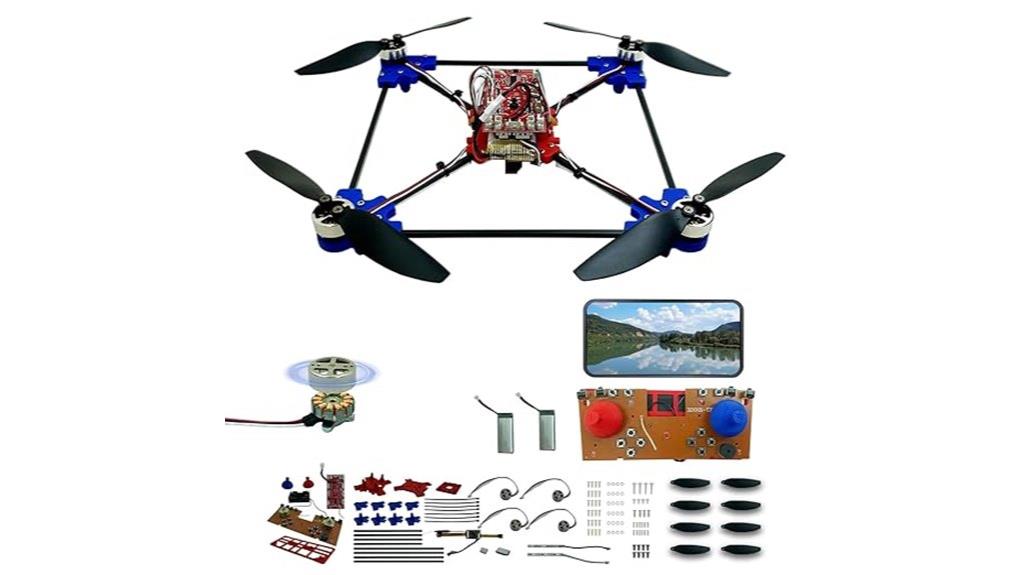
For enthusiasts enthusiastic to master drone mechanics and electronics, the Quadrotor Drone DIY Kit with Brushless Motor and 360° Flip offers a real challenge. It requires manual assembly, including fuselage construction and motor installation, taking about 1.5 hours. Equipped with advanced optical flow positioning, high-power brushless motors, and a flip function, it delivers up to 30 minutes of flight time. Designed for users over 14, it’s a complex project with a five-star difficulty level. While some assembly parts may be tricky or unclear, technical support helps. This kit is perfect for builders seeking hands-on learning and customization, despite its stability limitations compared to commercial drones.
Best For: DIY enthusiasts, makers, and students interested in hands-on learning, building, and customizing drones with a focus on mechanics and electronics.
Pros:
- Provides a comprehensive and educational DIY experience with detailed assembly instructions.
- Includes advanced features like optical flow positioning, 360° flip, and real-time video for engaging flight performance.
- Cost-effective kit with spare parts and accessories, fostering experimentation and repairs.
Cons:
- Assembly is challenging and time-consuming, requiring patience and technical skill.
- Some parts and instructions may be unclear or difficult to manipulate, with occasional quality control issues.
- Less stable and polished compared to commercial drones, making it more suitable for indoor, controlled flying environments.
REC S550 DIY Hexacopter Drone Development kit (Value Pack)

The REC S550 DIY Hexacopter Drone Development Kit (Value Pack) stands out as an ideal choice for experienced hobbyists and professionals who want to customize and upgrade their aerial platforms. It features a durable carbon fiber frame, a Pixhawk 2.4.8 flight controller, and six high-quality OEM 2212-920KV brushless motors. The kit supports 10-12 inch propellers and includes ESCs, power modules, and Bluetooth remote control capabilities. Although assembly requires basic soldering skills and some additional parts, it offers a rewarding DIY experience with significant lift capacity and customization potential. Perfect for advanced users aiming to develop specialized drones for research, aerial photography, or payload delivery.
Best For: experienced hobbyists and professionals seeking a customizable, durable drone platform for research, aerial photography, or payload delivery.
Pros:
- Durable carbon fiber frame enhances strength and lightweight performance
- Supports high customization with open-source flight controller and upgrade options
- Offers significant lift capacity suitable for various payloads and advanced applications
Cons:
- Assembly requires basic soldering skills and additional parts, which can be challenging for beginners
- Lacks comprehensive instructions and some necessary components, potentially complicating setup
- Mixed customer reviews indicate it may be more suitable for experienced users rather than beginners
BETAFPV Cetus Pro FPV Kit with LiteRadio 2 SE & VR02 Goggles

Designed specifically for FPV beginners, the BETAFPV Cetus Pro FPV Kit with LiteRadio 2 SE and VR02 goggles offers an all-in-one setup that simplifies entry into drone racing and freestyle flying. It includes a durable, lightweight drone with multiple flight modes, a responsive transmitter, and goggles suitable for indoor and outdoor use. While flight times are around three minutes per battery, the kit’s features—like altitude hold, turtle mode, and collision detection—make learning easier. Though some users find the goggles and build quality toy-like, the kit remains an affordable, resilient option for those starting their FPV journey, especially with extra batteries for extended practice.
Best For: beginner FPV enthusiasts seeking an affordable, all-in-one drone kit for indoor practice and skill development.
Pros:
- User-friendly design with multiple flight modes and beginner-friendly features like altitude hold and collision detection.
- Durable construction that resists crashes, making it ideal for learners.
- Comes with an inclusive package—transmitter, goggles, batteries, charger, and case—facilitating easy setup and use.
Cons:
- Limited flight time of around three minutes per battery, requiring multiple batteries for extended flying.
- Build quality and goggles are toy-like, with some users noting limited adjustability and lower image stability.
- Possible malfunctions in Normal mode and sensitivity issues with the remote control at throttle extremes.
STEM Quadcopter Building Kit with Coreless Motors
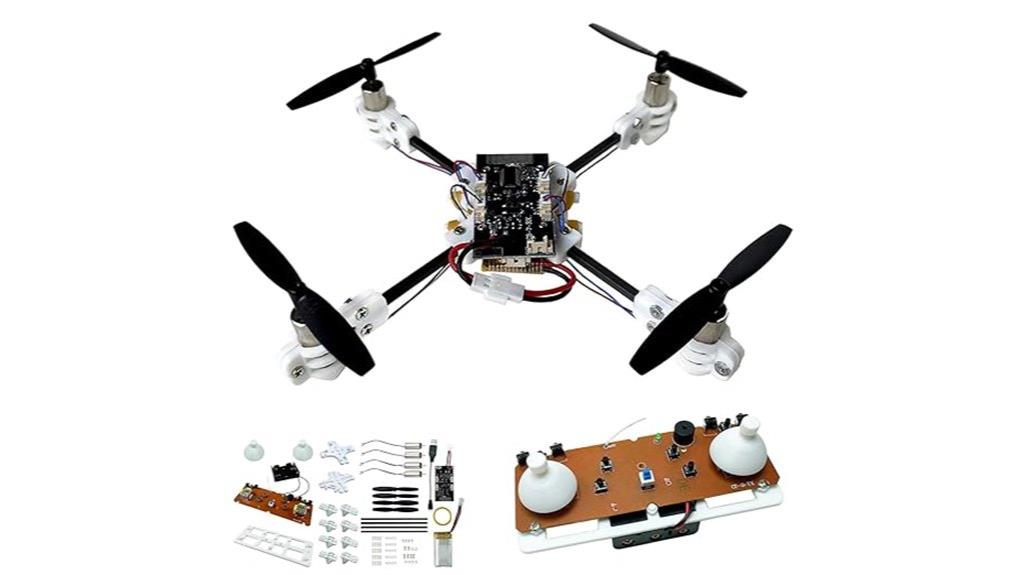
If you’re looking for a challenging yet rewarding way to deepen your understanding of drone technology, the STEM Quadcopter Building Kit with Coreless Motors is an ideal choice. It involves manual assembly from first screw to final setup, taking about 1.5 hours, and is designed for users aged 14 and above. The kit emphasizes hands-on learning, with detailed instructions and technical support to guide you through a complex, 5/5 difficulty project. As you build, you’ll gain valuable insights into drone mechanics, electronics, and aerodynamics. Once assembled, the drone offers impressive flight features like flips, one-key takeoff, and adjustable speed, making it both educational and fun.
Best For: DIY enthusiasts, students, and hobbyists aged 14 and above seeking an engaging, educational drone-building experience that challenges their practical skills and problem-solving abilities.
Pros:
- Promotes hands-on learning with detailed instructions and technical support
- Enhances understanding of drone mechanics, electronics, and aerodynamics
- Offers exciting flight features like flips, one-key takeoff, and adjustable speed
Cons:
- Highly challenging project requiring patience and manual assembly skills
- Lengthy assembly process of approximately 1.5 hours with a difficulty level of 5/5
- May be unsuitable for those easily distracted or lacking problem-solving experience
GILOBABY Mini Drone for Kids and Beginners
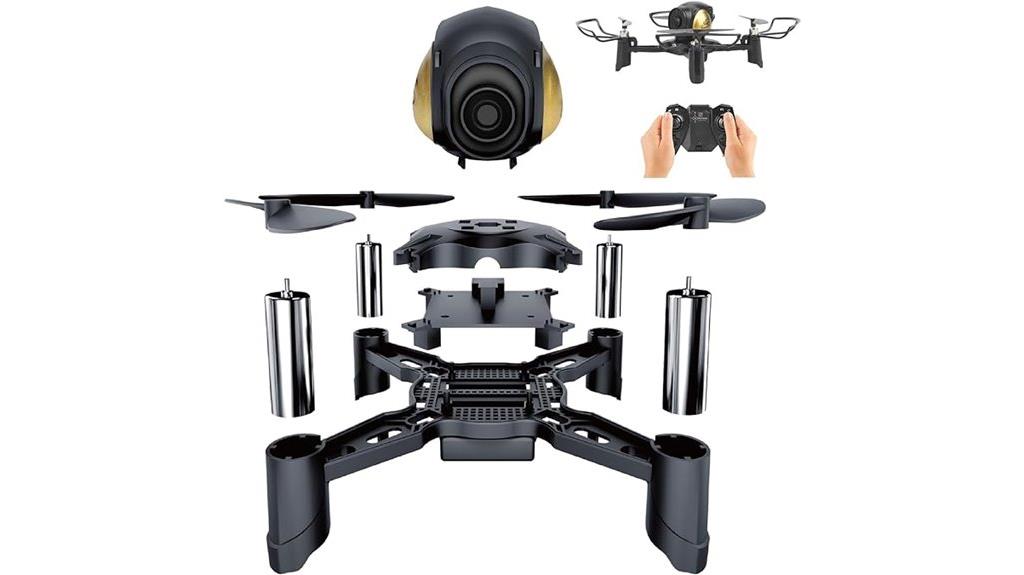
For parents and educators seeking an accessible entry point into drone technology, the GILOBABY Mini Drone for Kids and Beginners stands out with its user-friendly features. It offers 360-degree movement, adjustable speed, and modes like one-key takeoff, landing, and headless mode, making flying straightforward for beginners. The lightweight design (4.8 ounces) and durable ABS construction ensure safety for indoor and outdoor use. While battery life is limited to around 5-7 minutes, assembly is easy, and customer support is responsive. It’s an affordable, educational toy that helps children develop STEM skills, coordination, and confidence, despite some durability concerns over prolonged use.
Best For: beginners, children, and educators looking for a safe, easy-to-fly drone that encourages STEM learning and creativity.
Pros:
- User-friendly features with multiple flight modes and adjustable speeds for easy control
- Lightweight, durable ABS construction suitable for indoor and outdoor use
- Promotes STEM skills, hand-eye coordination, and confidence through assembly and flight experience
Cons:
- Limited battery life of around 5-7 minutes, with some reports of shorter flight times
- Motors may overheat or break after minimal use, affecting durability
- Lacks a camera and has small instructions that can be difficult to read, requiring careful handling
Drone with Camera 4k, GPS HD Drones for Adults

The Drone with Camera 4K, GPS HD Drones for Adults stands out as an excellent choice for those seeking high-quality aerial photography combined with advanced navigation features. Its 4K camera captures stunning videos and 8K photos, while GPS positioning guarantees precise control and automatic return. Equipped with obstacle avoidance, follow-me, and trajectory flight modes, it’s versatile for various aerial tasks. Despite some reports of control issues beyond 75 yards, its foldable design and 60-minute flight time make it portable and practical. Perfect for enthusiasts and professionals alike, it offers a balance of performance and ease of use, ideal for capturing breathtaking imagery from above.
Best For: enthusiasts and professionals seeking high-quality aerial photography with advanced navigation features and portability.
Pros:
- 4K camera with 8K photo capability and real-time HD transmission for stunning visuals
- GPS positioning, automatic return, and obstacle avoidance ensure precise and safe flights
- Foldable design with 60-minute flight time and lightweight construction for easy portability
Cons:
- Control range issues beyond 75 yards with potential loss of transmission and responsiveness
- Vulnerable plastic material may be prone to damage upon impact
- Reports of spontaneous flying and GPS failure affecting flight stability and control
Holy Stone GPS Drone with 4K Camera (HS175D)

The Holy Stone GPS Drone with 4K Camera (HS175D) stands out as an excellent choice for researchers seeking a portable drone with high-quality imaging and advanced flight features. It sports a 4K ultra-clear camera with a 110° wide-angle lens, adjustable up to 90°, capturing sharp images and videos. With GPS auto return, follow-me tracking, and waypoint flying, it offers versatile flight modes. Its foldable design and lightweight build make it easy to carry, while dual batteries provide up to 46 minutes of flight. However, some users report connectivity issues and stability concerns, so proper handling and realistic expectations are essential for ideal research use.
Best For: researchers and hobbyists seeking a portable drone with high-quality 4K imaging and versatile flight capabilities for casual or field use.
Pros:
- High-resolution 4K camera with adjustable lens for sharp images and videos
- Advanced flight features like GPS auto return and follow-me tracking for versatile operation
- Foldable design and lightweight build for easy portability and outdoor travel
Cons:
- Connectivity issues and stability concerns reported by some users
- Potential reliability and performance variability, including early battery alerts and crashes
- Packaging inconsistencies and risk of receiving used or refurbished units
N11 PRO GPS Drone with Camera (4K UHD, 90 Min Flight)

With its lightweight design and foldable structure, the N11 PRO GPS Drone with Camera is ideal for researchers who need a portable yet capable aerial platform. Weighing under 0.55 pounds, it avoids FAA registration and is easy to carry in its durable case. Its alloy brushless motors deliver wind resistance, quiet operation, and up to 90 minutes of flight with three batteries. The drone’s 4K UHD camera offers high-resolution photos and smooth 1080p videos, with a 100° adjustable lens. Featuring GPS-assisted auto return and stable hover, it’s suitable for outdoor research. However, lacking obstacle avoidance and with some connectivity limitations, it’s best for controlled environments and beginner-friendly projects.
Best For: beginner hobbyists and researchers seeking a lightweight, portable drone with decent flight time and 4K camera capabilities for recreational photography and outdoor projects.
Pros:
- Lightweight, foldable design with durable carrying case for easy portability
- Up to 90 minutes of flight with three batteries, suitable for extended outdoor use
- GPS-assisted auto return and stable hover features enhance ease of flying and positioning
Cons:
- Lacks obstacle avoidance, requiring cautious operation in cluttered environments
- WiFi connection range for camera is limited, with potential signal loss over 1500-2000 feet
- Some users report shaky video footage and drift during hover, indicating potential build and stability issues
M5Stamp Fly Drone Development Kit with M5StampS3, 300mAh Battery, Sensors & Motors

If you’re seeking a versatile drone platform for education or research, the M5Stamp Fly Drone Development Kit stands out thanks to its open-source design and extensive sensor suite. It’s compact, adjustable, and packed with features like obstacle avoidance, altitude control, and precise navigation using sensors such as BMI270 gyroscope and VL53L3 distance sensors. Powered by the ESP32-S3 microcontroller, it supports WiFi and Bluetooth connectivity, making remote control easy. The 300mAh battery provides decent flight time, while expansion options and firmware customization allow for tailored experiments. Weighing just 36.8 grams, it’s an excellent choice for developing innovative drone projects in a compact form.
Best For: enthusiasts, educators, and researchers seeking a customizable, open-source drone platform for learning, experimentation, and development projects.
Pros:
- Open-source firmware allows for extensive customization and programming flexibility.
- Equipped with a comprehensive array of sensors for precise navigation and obstacle avoidance.
- Compact, lightweight design suitable for educational and research environments.
Cons:
- Limited control range of about 3 meters, which may restrict outdoor or long-distance use.
- Requires some technical knowledge for setup, firmware modification, and expansion.
- Flight time is constrained by the 300mAh battery, potentially limiting extended use.
Factors to Consider When Choosing Modular Drone Kits for Research
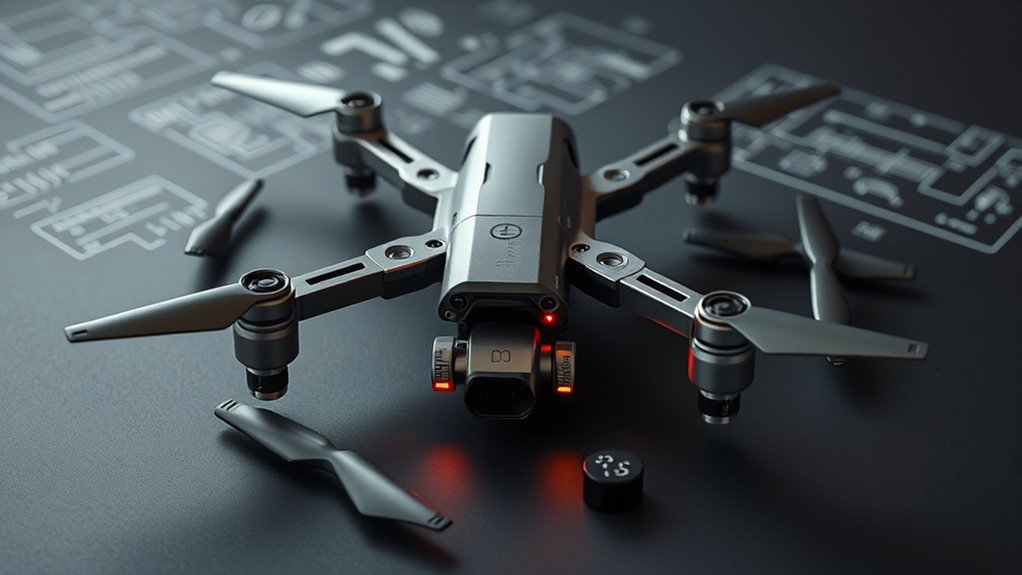
When selecting a modular drone kit for research, I focus on compatibility with existing components and how easily I can assemble it. I also consider sensor options and whether the power and battery life meet my project needs. Finally, I look at the kit’s expandability and potential for future upgrades to guarantee long-term versatility.
Compatibility With Components
Choosing a modular drone kit for research requires careful attention to compatibility with your components. I always ensure the kit supports the same communication protocols—like Wi-Fi, Bluetooth, or RF—as my existing hardware. It’s essential to verify that the flight controller or main control board can handle the sensors, cameras, and modules I plan to use. I also check voltage and power requirements to avoid damaging components or facing performance issues. Additionally, I look for standardized or adjustable mounting options—such as screw holes, brackets, or connectors—that fit various parts. Finally, I review the firmware and software support, favoring open-source options that allow seamless integration and customization of new modules. Compatibility is key to building a flexible, reliable research drone.
Ease of Assembly
Selecting a modular drone kit involves more than just compatibility; ease of assembly plays a vital role in the overall research process. Some kits are straightforward, featuring quick snap-together components and pre-assembled parts, making setup faster and less frustrating. Beginners benefit from detailed instructions, video tutorials, and clear labeling, which help reduce errors and save time. Conversely, advanced kits may require manual wiring, calibration, and firmware programming, increasing complexity and assembly time. The quality of parts, clarity of instructions, and technical skill level all influence how easy a kit is to build. When choosing a kit, I consider these factors carefully to guarantee I can assemble it efficiently, allowing me to focus on research rather than prolonged setup.
Sensor Integration Options
Integrating sensors into a modular drone kit is essential for enabling precise navigation and environmental awareness. When choosing a kit, I consider compatibility with various sensors like optical flow, ultrasonic, LiDAR, GPS, and obstacle avoidance modules, which are crucial for research accuracy. The drone’s flight controller and expansion ports determine how easily I can add or upgrade these sensors. Some kits feature plug-and-play modules, simplifying setup, while others require custom wiring and firmware adjustments, affecting flexibility and complexity. The right sensor options directly impact data quality, obstacle detection, altitude control, and autonomous flight capabilities—all critical for research projects. Ultimately, I prioritize sensor compatibility and expandability to ensure my drone meets specific environmental and data collection needs efficiently.
Power and Battery Life
Battery life and power capacity play a vital role in ensuring my research drone can operate effectively throughout extended sessions. I look for kits with high-capacity batteries, like those offering up to 90 minutes of flight time with multiple packs. The type of battery matters too—LiPo batteries provide quick charging and strong power output, while lithium-ion batteries tend to last longer but take more time to recharge. The number of batteries included and how easily I can swap or charge them directly impacts continuous operation. Flight times vary widely; some kits give just 15 minutes, while advanced setups can reach over an hour. It’s essential to verify the maximum supported power system and consider options for upgrading batteries or adding external packs for longer research missions.
Expandability and Upgrades
When choosing modular drone kits for research, I prioritize expandability and upgrade options that let me customize and enhance my drone’s capabilities over time. Having the ability to add or upgrade components like cameras, sensors, and flight controllers ensures the drone stays relevant for evolving project needs. Compatibility with various peripherals, such as obstacle avoidance modules or GPS units, boosts versatility for different experiments. Open-source firmware and hardware interfaces are vital, as they enable me to develop custom algorithms or integrate specialized hardware seamlessly. Upgrading motors, batteries, and communication modules allows the drone to handle increased payloads or longer flights—key for long-term research. Additionally, a modular design simplifies maintenance and component replacement, minimizing downtime and reducing long-term costs.
Software and Firmware Support
Choosing a modular drone kit with robust software and firmware support is essential for research flexibility. I look for open-source firmware or frequent updates because they allow me to customize and improve the drone’s capabilities. Compatibility with popular programming environments and development platforms is a big plus, making it easier to adapt the drone to specific research needs. I also check if the firmware includes key features like obstacle avoidance, flight stabilization, and autonomous navigation, which are critical for complex experiments. Extensive documentation, SDKs, and active user communities are invaluable for troubleshooting and collaboration. Finally, I ensure that the firmware allows seamless integration of additional sensors or hardware modules, giving me the versatility to tailor the drone to unique research projects.
Safety and Durability
Ensuring safety and durability in modular drone kits is essential for reliable research operations. I look for kits built from tough materials like carbon fiber or reinforced plastics, which can handle crashes and tough environments. Protective features such as blade guards, reinforced frames, and impact-resistant casings are crucial for safe operation. High-quality electronics—reliable sensors and robust motors—help prevent failures that could compromise safety. I also check if the design allows for easy maintenance and quick component swaps, minimizing downtime and extending the kit’s lifespan. Additionally, safety certifications and compliance with industry standards are vital, confirming the kit meets rigorous safety and durability requirements. Prioritizing these factors ensures my research remains consistent, safe, and effective over time.
Frequently Asked Questions
What Are the Safety Features Included in Top Modular Drone Kits?
Top modular drone kits include safety features like automatic return-to-home, obstacle avoidance sensors, and failsafe landing modes. I always look for kits with these options because they help prevent crashes and protect both the drone and surrounding people. Many also have GPS stabilization and low-battery alerts, giving me peace of mind during my research. These features guarantee safer operation, especially in complex environments or when working with sensitive equipment.
How Easy Is It to Upgrade or Customize These Drone Kits?
Did you know nearly 80% of researchers find modular drone kits highly customizable? I’ve found that upgrading or customizing these kits is surprisingly straightforward. Most come with plug-and-play components and clear instructions, making it accessible even for beginners. You can swap sensors, cameras, or motors with minimal tools. It’s designed for flexibility, so you can tailor your drone to specific research needs without much hassle, saving you time and effort.
Which Kits Are Most Suitable for Advanced Research Applications?
For advanced research, I recommend kits like the DJI Matrice 300 RTK and the Pixhawk-based systems. These offer high customization, precise sensors, and robust payload options, making them ideal for complex experiments. They’re scalable, compatible with various modules, and support sophisticated software integration. If you need flexibility and cutting-edge capabilities, these kits provide the reliability and performance essential for rigorous research projects.
What Are the Recommended Maintenance Routines for Modular Drones?
Think of maintaining your modular drone like tending a high-performance engine—regular care keeps it running smoothly. I recommend checking connections and replacing worn parts weekly, cleaning sensors and rotors after each flight, and updating firmware regularly. Also, perform thorough pre-flight inspections to catch issues early. This routine minimizes downtime, extends your drone’s lifespan, and guarantees peak performance for your research projects. Consistent maintenance is the key to reliable results.
How Do Modular Kits Differ in Battery Life and Flight Endurance?
Modular drone kits differ mainly in battery life and flight endurance based on their battery capacity and design. I’ve noticed that higher-capacity batteries provide longer flight times, but they also add weight, which can slightly reduce endurance. Some kits allow easy swapping of batteries for extended missions, while others have integrated batteries. It’s essential to take into account your research needs—whether you prioritize quick swaps or longer, uninterrupted flights.
Conclusion
If you choose one of these modular drone kits, you’re not just picking a tool—you’re opening the entire universe of aerial innovation. Imagine your research soaring higher than ever, with capabilities so advanced they seem straight out of a sci-fi movie. These kits will transform your projects into legendary feats of technology, making you feel like an astronaut steering uncharted skies. Get ready to elevate your research to epic, universe-defining heights!
